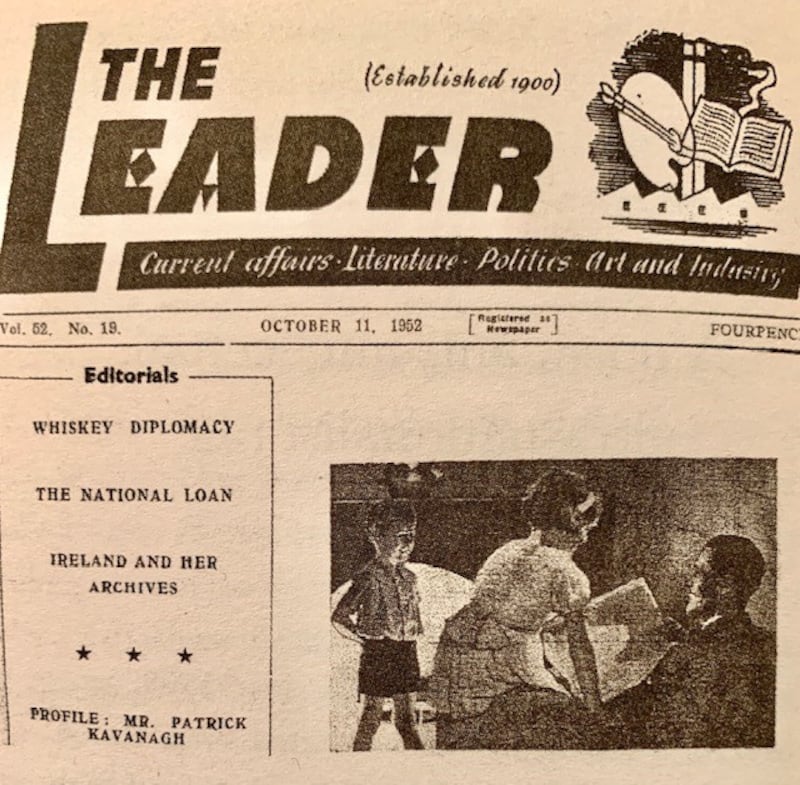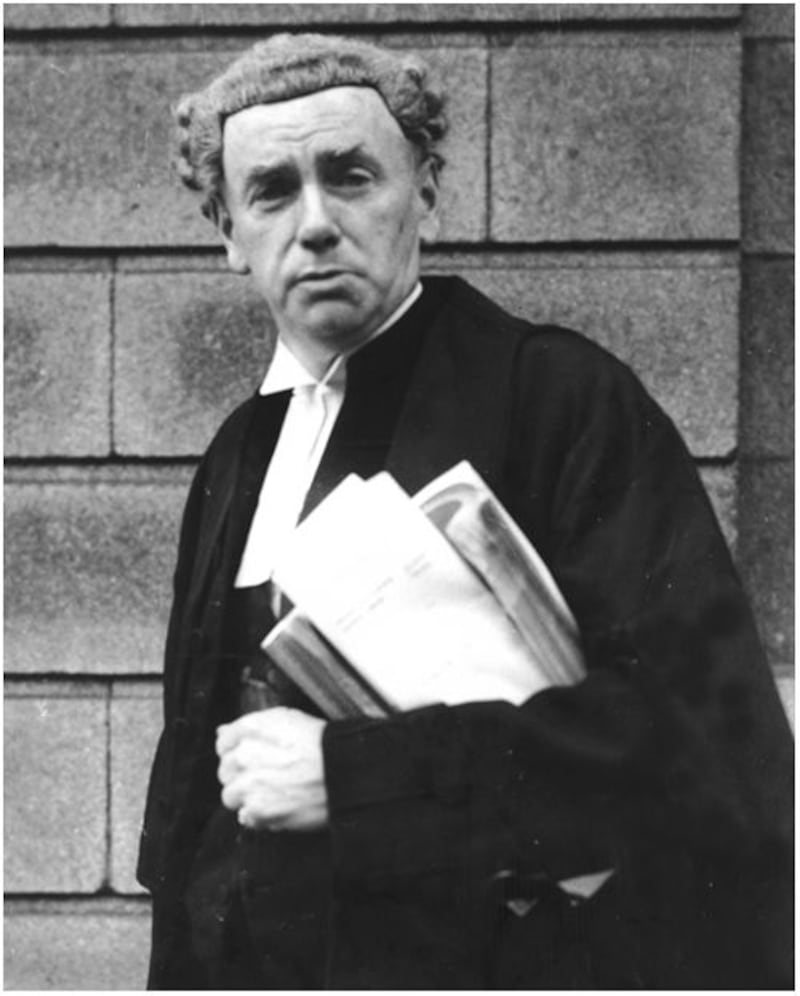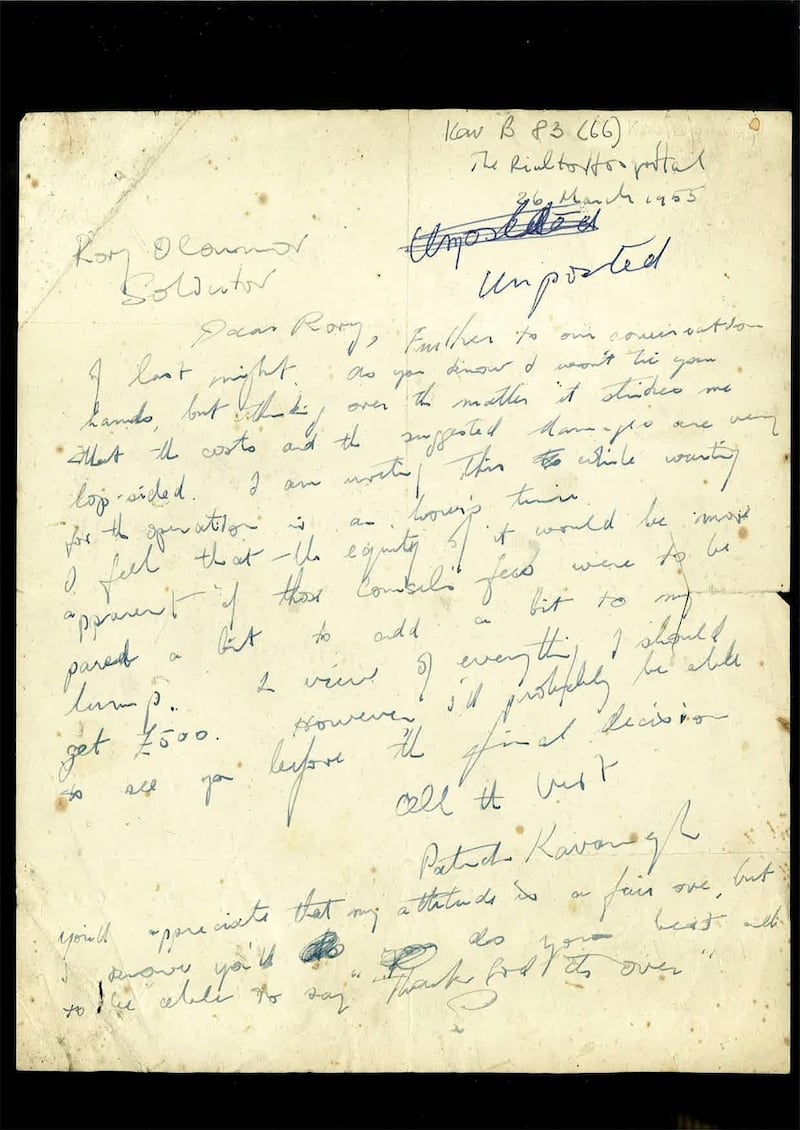In 1939 Patrick Kavanagh came to Dublin to work full-time as a writer. A daunting task at any time, in 1940s Dublin this was almost impossible.
Kavanagh observed that “poetry is a luxury trade… a man has no business adventuring into it unless he has buckets of money”. Despite many war-time shortages, jealousy and petty snobbery were in plentiful supply. The big raw-boned Monaghan man striding Dublin’s streets drew sneers from city slickers. (On observing a man driving a manure cart, one wag said acidly: “I see Paddy Kavanagh is moving house”).
Nonetheless, by the early 1950s Kavanagh was a well-known literary figure, having produced critically-acclaimed – if controversial – work such as The Green Fool and Tarry Flynn, and a long poem, The Great Hunger, which depicted the loneliness, depression and sexual frustration of the small farmer.
A plethora of small literary journals were then circulating in Ireland. One of them, The Leader, published a “Profile” of Kavanagh in October 1952. The piece painted an uncomplimentary picture of Kavanagh on a bar-stool in McDaids, firing a “malevolent” insult at the barman before gulping down a ball of malt. In a voice reminiscent of “a load of gravel sliding down the side of a quarry”, Kavanagh booms out “Yous have no merit, no merit at all,” to his admirers before leaving for lunch in the Bailey and a visit to the bookies.

The piece included an attack on Kavanagh’s Weekly, an ill-fated broadsheet run by Kavanagh and his brother Peter, who between them wrote everything in it, including the so-called Letters to the Editor.
Incensed, Kavanagh decided to sue. His first reaction to this “nasty libel” was that “there may be money in it”. He was buoyed up after a visit to his solicitors: “The view is I cannot lose… I am confident of getting anything from £500 upwards…”
Kavanagh was not unfamiliar with the legal process. His father had helped locals in Inniskeen to draft wills (using Pears Encyclopaedia). Kavanagh had recovered modest damages after a B&I lorry knocked him off his bicycle near Butt Bridge. Notably, in 1939 the publishers of Kavanagh’s semi-autobiographical novel The Green Fool had been sued in England for libel by the Irish surgeon Oliver St John Gogarty because of a reference in the novel to a visit by Kavanagh to Gogarty’s house, where Kavanagh “mistook Gogarty’s white-robed maid for his wife – or a mistress”.
Gogarty had himself been sued for libel by Harry Sinclair, a Dublin antiques dealer who Gogarty suggested in his memoir was more interested in “new mistresses than old Masters”. (Samuel Beckett gave evidence for Sinclair, but could not resist correcting defending counsel’s deliberate mispronunciation of the name Marcel Prowst).
Perhaps the successful Gogarty and Sinclair lawsuits persuaded Kavanagh that libel actions were easy money, especially as he had little money of his own, despite occasional hand-outs from Archbishop John Charles McQuaid. As Anthony Cronin observed: “Kavanagh, being a literary man, dreamed of libel”. However, Kavanagh’s anxiety to protect what he regarded as “the sacred space” occupied by the poet in Ireland should not be overlooked.
There were no settlement negotiations beforehand. On Wednesday, February 3rd, 1954 Kavanagh appeared at the Four Courts in a borrowed dark Burberry coat, a dark hat and carrying a briefcase. His legal team were anxious to present Kavanagh as a serious man following a serious profession: “He leads a quiet life; early to bed, early to rise” according to his counsel Sir John Esmonde SC’s opening address, which also criticised the cowardly nature of the anonymous article.
However, the dramatic highpoint of the case was the cross-examination of Kavanagh by John A Costello SC. A former and future taoiseach, and TD for what is now Dublin Bay South, (Kavanagh’s own constituency), as counsel for The Leader Costello highlighted the article’s flattering reference to Kavanagh’s The Great Hunger. “We say you are the greatest living poet,” said Costello. “That doesn’t butter much parsnips,” was Kavanagh’s reply.

At times the courtroom rocked with laughter. Asked if parts of The Great Hunger were suppressed for indecency, Kavanagh answered “Practically all the obscene bits are still in”. Costello wondered had the police called to see him about the poem. “They asked me my views,” said Kavanagh. “We had a talk about Chaucer. They didn’t know much about him.”
Daily queues formed outside court for a seat. There were echoes of Oscar Wilde’s doomed libel hearing: the witty writer being pursued by the determined counsel, with Costello mock-protesting his ignorance: “You are cleverer than me,” he said. “I am not a poet, I am only a working barrister.”
Gradually, Costello’s cross-examination of Kavanagh’s credibility made inroads. Other magazines had published unflattering pieces about Kavanagh; why hadn’t he sued them? Kavanagh had written stinging criticisms of poets such as Austin Clarke; maybe Kavanagh could dish it out, but couldn’t take it? An unwise and pointless denial by Kavanagh of a friendship with Brendan Behan (who Kavanagh wrongly suspected of being the author of the article) led to a dramatic court-room moment when a copy of Kavanagh’s Tarry Flynn was then produced, inscribed and dedicated by the author to Behan: “For my friend Brendan, poet and painter, on the day he decorated my flat.”
The defence did not give evidence. After closing speeches by counsel, the judge, Teevan, (whose first case this was) told the jury that if they felt the article “as a whole” was not defamatory, they could ignore the innuendoes complained of – which suggested Kavanagh was a sponger, shallow, unjustifiably abusive, and malicious towards RTÉ – since they were “not all that important”. Although the trial took six days, the jury were back in under two hours: the article was not “as a whole defamatory”. Kavanagh had lost.
Kavanagh’s legal team advised there were grounds for an appeal. An Appeal Fund Committee was established. Contributors included TS Eliot, John Betjeman and Jack B. Yeats. The Supreme Court appeal was heard in November 1954. By then Kavanagh was suffering from lung cancer. He was admitted in 1955 to the Rialto Hospital for surgery which necessitated the removal of his left lung – and a rib, which Kavanagh kept as a souvenir.
In March 1955 the Supreme Court delivered judgment. By a 3-2 majority the jury verdict was set aside, and the case sent back for a retrial. The majority said Teevan’s direction about the innuendoes had been confusing. Kingsmill Moore felt the article would have conveyed to most readers that Kavanagh was “something of a poseur, unsubtle, opinionated and overbearing”.

Negotiations then began, and a settlement was reached. The terms were never disclosed, but it seems there was an “all-in” payment to include damages and costs. A revealing letter written by Kavanagh to his solicitor during negotiations claims “the costs and the suggested damages are very lop-sided… I feel that the equity of it would be more apparent if those counsel’s fees were to be pared a bit to add a bit to my lump. In view of everything I should get £500.”
Other funds came later from a surprising source. Two months after the original trial, the government collapsed. Costello was again elected taoiseach. During the election Costello met Kavanagh outside a polling station. “I hope you have no grudge against me,” said Costello. “On the contrary, I’ve just voted for you,” said Kavanagh. Correspondence ensued. Kavanagh wrote repeatedly to Costello, asking to be fixed up with some kind of paying job. Costello contacted the president of UCD, Michael Tierney, who arranged for Kavanagh to be appointed lecturer in poetry at a salary of £400 a year, though how many lectures were given is unclear.
Kavanagh died in November 1967 aged 63. His contribution to Irish literature is for others to speak on; it is undoubtedly significant. The legacy of his libel action against The Leader is more nuanced, being a reminder of the need for caution before issuing proceedings, the entrenched nature of Dublin’s urban/rural divide, the small-minded savagery of some of Ireland’s literary wars, the capacity of juries to sometimes get it wrong – and the Supreme Court to sometimes get it right, the private kindnesses of certain public figures, the benefits of the legal “no foal no fee” tradition, and the Irish public’s ceaseless fascination with defamation actions. “I made the Iliad from such /a local row. Gods make their own importance.”
















